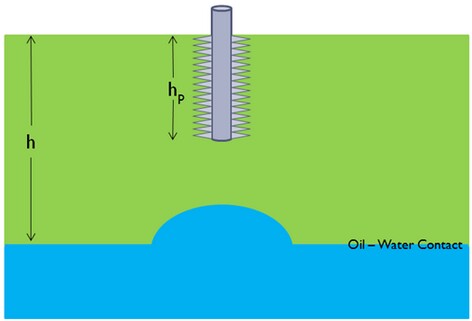|

  
|
||
Several vertical well critical rate correlations are available in the literature, most of which are included within these routines.

In all of vertical well coning calculations the assumption is made that the perforations are always located at the top of the oil zone, thereby maximising the distance between the perforations and the oil-water contact.
It is important to note that these correlations are valid for a continuous oil pay zone with oil-water contact or gas-oil contact or both. These correlations show that the critical rate depends upon effective oil permeability, oil viscosity, density difference between oil and water or oil and gas, well penetration ratio, and vertical permeability.
The use of this routine is highlighted with the following example.
References:
Bournazel, C., and Jeanson, B., "Fast Water Coning Evaluation", SPE Paper 3628, 1971
Sobocinski, D. P., and Cornelius, A. J., "A Correlation for Predicting Water Coning Time", JPT, May 1965.
Kuo, C. T., and Desbrisay, C. L., "A Simplified Method for Water Coning Predictions", SPE Paper 12067, 1983
Hoyland, L. A., Papatzacos, P., and Skjaeveland, S. M., "Critical Rate for Water Coning: Correlation and Analytical Solution", SPE Paper 15855, 1989
Chierici, G. L., "Principles of Petroleum Reservoir Engineering Volume 2", Springer-Verlag 1994
Joshi, S., "Horizontal Well Technology", Pennwell, 1991
Chaperon, I., "Theoretical Study of Coning Toward Horizontal and Vertical Wells in Anisotrophic Formations: Subcritical and Critical Rates", SPE Paper 15377, 1986.
Schols, R. S., "An Empirical Formula for the Critical Oil Production Rate", Erdoel Erdgas, January 1972
Meyer, H. I., and Garder, A. O., "Mechanics of Two Immiscible Fluids in Porous Media", J. Applied Physics, November 1954
Page url: http://www.YOURSERVER.com/help/index.html?vertical_wells.htm